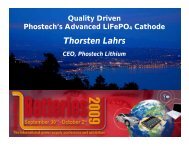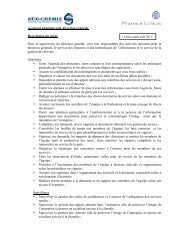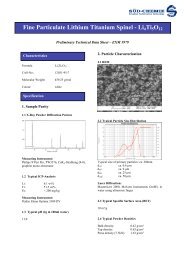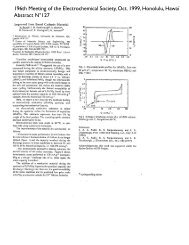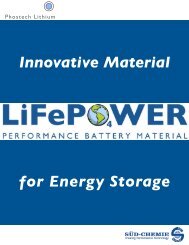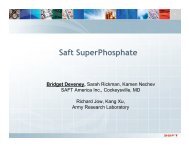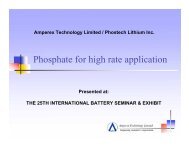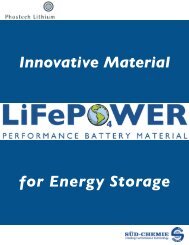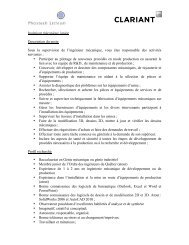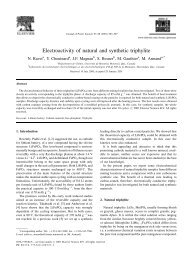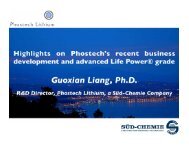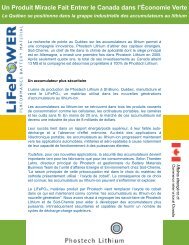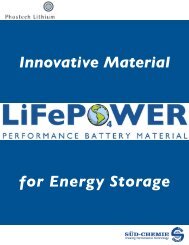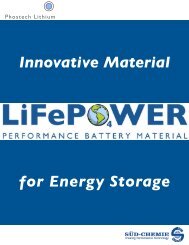Phosphate cathodes and lithium storage batteries - Phostech ...
Phosphate cathodes and lithium storage batteries - Phostech ...
Phosphate cathodes and lithium storage batteries - Phostech ...
You also want an ePaper? Increase the reach of your titles
YUMPU automatically turns print PDFs into web optimized ePapers that Google loves.
<strong>Phosphate</strong> <strong>cathodes</strong> <strong>and</strong><br />
energy-<strong>storage</strong> <strong>lithium</strong> <strong>batteries</strong><br />
Michel Gauthier<br />
President <strong>Phostech</strong> Lithium<br />
Inno 09<br />
Montréal, April 23-24, 2009
Presentation plan<br />
• Energy source <strong>and</strong> <strong>storage</strong> by carbon<br />
• Electrochemical energy <strong>storage</strong><br />
• Why a <strong>lithium</strong> battery for transportation ?<br />
• <strong>Phostech</strong>, C-LiFePO4 <strong>and</strong> large Li-<strong>batteries</strong><br />
• <strong>Phostech</strong>’s status & market development<br />
• <strong>Phostech</strong>’s vision of the future
Energy sources <strong>and</strong> C-<strong>storage</strong><br />
The sun is the source of most<br />
energy on earth<br />
Nature uses carbon chemistry<br />
to convert <strong>and</strong> store energy in<br />
complex processes:<br />
6H2O + 6CO2 + γ (CH2O)6 Fatty acids (<strong>storage</strong>)<br />
Fatty acid or (CH2O) 6 ATP <br />
6H2O + 6CO2 + energy<br />
Man gets energy <strong>and</strong> power<br />
from bio or fossil C-<strong>storage</strong> at a<br />
price…:<br />
The Cell, Garl<strong>and</strong>,
Electrochemical <strong>storage</strong> of energy<br />
With Galvani, Volta, Planté, electricity <strong>and</strong> electrochemical<br />
<strong>storage</strong> became available to mankind:<br />
La bioélectrogénèse<br />
Galvani, 1780, Fe-Cu<br />
Volta, 1800<br />
Zn/Cu<br />
Lead-acid battery<br />
Planté, 1859, Pb-PbO2
Energy <strong>storage</strong> <strong>and</strong> transportation<br />
Edison <strong>and</strong> the electric vehicle<br />
No progress from 1913 to ~ 1970<br />
Specific Power (W/kg)<br />
1000<br />
100<br />
10<br />
Specific Power-Energy representation<br />
of vehicle speed <strong>and</strong> range.<br />
30km/h<br />
60<br />
Electric vehicule<br />
120 Km/h<br />
10<br />
100 1000<br />
Specific energy (Wh/kg)
From lead to <strong>lithium</strong> <strong>and</strong> why ?<br />
Free energy of reaction<br />
= <strong>storage</strong> capacity<br />
ΔG = -n F E<br />
Specific energy<br />
(Wh/kg) = n F E / ΣR wt<br />
Specific power<br />
(W/kg) = V I / ΣR wt<br />
Lead Lithium Advantage/inconvenient<br />
207 gr/at. 7 gr/at. +++ Higher specific energy <strong>and</strong> power<br />
Max 2.2V Up to 5.2V +++ High energy <strong>and</strong> power<br />
Large ionic radius Smallest r ion = 0.06nm +++ Favorable to insertion structures<br />
Multivalent ion Monovalent ion +++ Favorable to Li + diffusion<br />
Water electrolyte Aprotic electrolyte --++ Organic solvents/polymers, Li salts<br />
Toxic element Non-toxic element +++ Sustainability <strong>and</strong> environment compatible
Li battery evolution in 50 years !<br />
Primary cells<br />
Li o -MnO 2<br />
Li o -SO 2 , SOCl 2<br />
Organic LE<br />
Li o -MoS 2 rech.<br />
Li o -MnO 2 rech.<br />
Molten salts<br />
LiAl/LiCl-KCl/FeS<br />
Lithium-ion<br />
Lithium metal<br />
Polymer Electrolyte<br />
Li o -polymère-VOx<br />
Li o -polymère-LiFePO 4<br />
Organic LE<br />
LiC 6 -LiCoO 2<br />
LiC 6 -Li(CoMnNi)O 2<br />
LiC 6 -LiFePO 4<br />
Gel LE<br />
LiC6-LiCoO 2<br />
LiC 6 -LiFePO 4<br />
Argo-Tech EV Blue Car<br />
HQ Avestor B0<br />
=>Bathium<br />
1960 1970 1980 1990<br />
2000 2010<br />
LE Rocking-chair<br />
Li 5 Ti 4 O 12 -LiMPO 4<br />
HEV-PHEV-EV<br />
Ionic LE<br />
Li o -LiMPO 4<br />
SLI, HEV<br />
Grid?<br />
-LiMPO 4<br />
?
The challenges of<br />
large <strong>lithium</strong> <strong>batteries</strong>:<br />
Challenges Status of <strong>lithium</strong>-ion <strong>batteries</strong><br />
1 Specific energy (Wh/kg) √ √ 3-4 times the lead acid demonstrated<br />
2 Specific power (W/kg) √√ Sustained, pulse & regen power achieved<br />
3 Cyclability (>> 2000, 100% DOD) √ Demonstrated at cell level<br />
4 Safety (cell <strong>and</strong> battery system) √ Achieved at the cell level<br />
5 Sustainability/environment compatibility √ Non-toxic <strong>and</strong> available elements, recycling?<br />
6 +10 years life (-30 to 60 o C, shocks..) Material thermal, chemical & physical stability?<br />
7<br />
Material & manufacturing costs<br />
($/kWh or $/kW)<br />
Components, design & process optimization need the<br />
benefit of large scale production<br />
The solution: LiFePO 4 ?
LiFePO4, Goodenough strikes again!<br />
Building on Whittingham’s discovery of<br />
the LiTiS2 intercalation electrode, J. B.<br />
Goodenough invented LiCoO 2 layered<br />
oxide (3.7V) that made possible the<br />
first Li-ion battery by Sony<br />
15 years later, he came back with a<br />
one-dimentional diffusion iron-based<br />
cathode LiFePO4 operating at 3.4V<br />
Cobalt based Lithium-ion<br />
-<br />
é<br />
C<br />
LiC6<br />
W e<br />
Li +<br />
é<br />
L iC oO 2<br />
C oO 2<br />
+<br />
++ Stable Li-reversible structure<br />
++ Widely available elements<br />
++ High voltage (3.4V) with Fe !!<br />
++ Covalent P-O bound, no O 2 ↑<br />
++ Two-phase flat voltage<br />
-- Low electronic conductivity<br />
-- Low Li-ion diffusion<br />
Triphylite LiFePO4 Heterosite Fe(Mn)PO4<br />
Synthetic triphylite<br />
<strong>Phostech</strong>, 1000 o C<br />
Iron b ased Lithium-ion<br />
é é<br />
W e<br />
Li +<br />
C LiFePO<br />
4<br />
LiC6<br />
FePO<br />
4
Li +<br />
<strong>Phostech</strong> Lithium’s short history<br />
1997: Hydro-Québec (HQ) obtains an exclusive license on patent from UT<br />
1999: C-LiFePO 4 patented by Université de Montréal (UdM), HQ <strong>and</strong> CNRS<br />
2001: UdM researchers set up <strong>Phostech</strong> after obtaining exclusive licenses to<br />
make/sell C-LiFePO 4 from HQ, UT, UdM <strong>and</strong> CNRS<br />
Süd-Chemie independantly initiates R&D on LiFePO 4 in Germany<br />
2003: Süd-Chemie patents a wet-process for making LiFePO 4<br />
2004: <strong>Phostech</strong> starts manufacturing in Québec on a solid-state process (P1)<br />
Süd-Chemie starts pilot operation on a wet-process (P2) in Germany<br />
Süd-Chemie initiates relationship (MOU) with <strong>Phostech</strong> Lithium<br />
2005: Süd-Chemie initial investment into <strong>Phostech</strong> Lithium<br />
2008: <strong>Phostech</strong> Lithium 100% owned subsidiary of Süd-Chemie
C-LiFePO 4 <strong>and</strong> <strong>Phostech</strong> Lithium<br />
After Goodenough, UdM-HQ solved the<br />
LiFePO4 low electronic conductivity with a<br />
pyrolytic C nano-deposit: C-LiFePO 4<br />
In parallel, UdM, <strong>Phostech</strong>/Süd-Chemie<br />
developed processes to make sub-micron C-<br />
LiFePO 4 particles solving the low D Li +<br />
limitation: the result, high power (up to 7 kW/<br />
kg peaks) <strong>and</strong> regen capability<br />
In 2001 <strong>Phostech</strong> was incorporated to<br />
develop <strong>and</strong> manufacture C-LiFePO 4 under<br />
exclusive licenses from UT/HQ/UdM/CNRS<br />
<strong>Phostech</strong> products P1 <strong>and</strong> P2 are sold<br />
worldwide <strong>and</strong> presently qualified by major<br />
Lithium battery manufacturers<br />
C ≈ 2nm<br />
C-LiFePO4<br />
LiFePO 4<br />
1-2 µ agglomerate
<strong>Phostech</strong>’s products <strong>and</strong> customers<br />
• <strong>Phostech</strong> produces an energy grade<br />
P1 (EV's, e-bike, <strong>storage</strong>,...) at its St-<br />
Bruno plant (600t/y capacity)<br />
• <strong>Phostech</strong> produces a power grade P2<br />
for Power tools <strong>and</strong> HEV applications<br />
at Süd-Chemie in Moosburg,<br />
Germany (150 t/y capacity)<br />
• Most St-Bruno plant sales are<br />
exported to Asia<br />
• Power grade P2 product/process is<br />
presently being qualified by major<br />
battery manufacturers<br />
• Discussions with governmental<br />
authorities concerning a new 2400 t/y<br />
plant in C<strong>and</strong>iac are being actively<br />
pursued
VL25Fe Cell based on LiFePO 4 P2<br />
Cell optimized for<br />
Medium Power/Medium Energy<br />
applications
C-LiFePO 4 cathode & large Li-Ion<br />
• Of all known <strong>cathodes</strong>, LiFePO 4 is<br />
the most stable <strong>and</strong> safest in a<br />
complete battery<br />
• Only LiFePO 4 <strong>and</strong> LiMn 2 O 4 are made<br />
of widely available elements<br />
required for EV <strong>and</strong> energy <strong>storage</strong><br />
needs<br />
• With scale <strong>and</strong> volume, the low<br />
cost synthesis of pure LiFePO 4 is<br />
possible<br />
• LiFePO 4 stability, low voltage <strong>and</strong><br />
abuse cycling tolerance make cell/<br />
battery design easier <strong>and</strong> will help<br />
decrease the overall battery cost<br />
Sources: Rocky Mountain Institute
Large cell cost optimization<br />
To meet PHEV/EV cost requirements all battery elements must be optimized<br />
or redesigned:<br />
Active <strong>and</strong> passive components: cost, cycle <strong>and</strong> calendar life (10-15 years…)<br />
Manufacturing processes: electrodes <strong>and</strong> cell<br />
Battery system design <strong>and</strong> safety<br />
The challenge: the interactive chemistry between all cell elements, eg:<br />
A low-voltage-cathode compatible salt must be anode compatible (SEI?)<br />
Contaminant from cathode might affect the anode performance (eg water ppm vs HF)<br />
Low cost current collector (Al) depends on salt or anode selection Li 4 Ti 5 O 12 vs LiC 6 ...
<strong>Phostech</strong>’s status as C-LiFePO 4 supplier<br />
• Strong IP position<br />
• Unique expertise on different synthesis processes<br />
• International network of suppliers <strong>and</strong> customers<br />
• <strong>Phostech</strong>'s products in qualification by major manufacturers of<br />
Li-ion <strong>batteries</strong>, including extensive Q/C procedure at every level<br />
in the manufacturing chain<br />
• Commitment to R&D, recent UdM/NSERC Chair announcement<br />
• <strong>Phostech</strong> provides a key element of Li-ion future<br />
• <strong>Phostech</strong> is working with US/Canadian cell/battery<br />
manufacturers, OEM users <strong>and</strong> governments to accelerate large<br />
Li-battery manufacturing in North America
<strong>Phostech</strong>’s key-IP summary
Process families to make LiFePO 4<br />
P1<br />
P2<br />
P3<br />
Fe source + Li source + P source
<strong>Phostech</strong>’s status as C-LiFePO 4 supplier<br />
• Strong IP position<br />
• Unique expertise on different synthesis processes<br />
• International network of suppliers <strong>and</strong> customers<br />
• <strong>Phostech</strong>'s products in qualification by major manufacturers of<br />
Li-ion <strong>batteries</strong>, including extensive Q/C procedure at every level<br />
in the manufacturing chain<br />
• Commitment to R&D, recent UdM/NSERC Chair announcement<br />
• <strong>Phostech</strong> provides a key element of Li-ion future<br />
• <strong>Phostech</strong> is working with US/Canadian cell/battery<br />
manufacturers, OEM users <strong>and</strong> governments to accelerate large<br />
Li-battery manufacturing in North America
<strong>Phostech</strong> employee’s vision !!!<br />
We do not speak<br />
about g reenhouse<br />
effect, we work on it!



